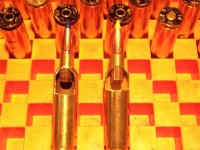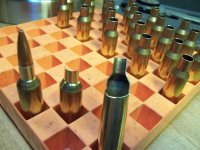Being new to this sport, I am still trying to both shoot and amass the required bits and pieces. Do I need to get Head Space Gauges made by the same gunsmith that built the rifle? Or, can they be made from the original reamer print and / or some type of measuring.
How about neck reamers to take out the donut but not effect the rest of the neck?
Thanks, Bob
OK......first things FIRST.
This post is specifically to you and to this op, it doesn't reply to, comment on, amend nor otherwise refer to any of the other excellent answers.
And, as usual, I'll take this post off in a whole nuther direction......
This is my answer, there are no others like it, it is mine
My comments will possibly be taken as offensive, when they are, the fault is mine.
Do I need to get Head Space Gauges made by the same gunsmith that built the rifle?
You ask about Headspace Gauges..... now here's a sticky wicket. It is my considered opinion that the "headspace gauge" referred to by Tony, at least those ref'd on pg 156 of his hardcover edition is something more commonly called a "gizzie."
NOW, let me digress, let me TAKE some of your time in hopes of SAVING time down the road. And I'ma pick on Tony Boyer some...... rightfully The King of Benchrest, but not specifically the best teacher of the sport. It's been said that Tony's "forgotten more than most people know about BR", and this is TRUE

It's also "the problem."
And let me digress a liddle more..... there is one solid TON of information on this, the premier Accuracy Board on thee net. There is also a LOT of confusion both internally and more specifically because there's an internal "language" to this sport. Same as any other sport.
It's also "the problem."
I say this to you and to all others with questions, "Please Understand, We Don't All Hear The Same Things.... We're Not All Walking The Same Piece Of Our Accuracy Journey.". . . . . . COMMUNICATION IS HARD!! But we all try help. And I beg of all folks asking questions, BE SPECIFIC, ask the question again if you don't understand the answer.
And then ask AGAIN....
So, back to the headspace gauges. You do not need your own headspace gauge. But you DO need a device for setting, measuring, comparing headspace! This is commonly called your gizzie (or gizzy) ....... (((But NOT Gizzard))).....
KaPische??
Typically a BENCHREST gunsmith will supply you with a little round/square/rectangular gage/gizzie made by running the reamer in just far enough to encapsulate the shoulder...... with this GAGE you can measure your headspace. By measuring your headspace you can set your sizing dies from a location remote to your rifle...... BUT!!!
Y'UGE BUTTT!!!
This is all predicated on another concept that gets inconveniently left out of the conversation....When a BR RIFLE is assembled by a BR GUNSMITH and used for BR COMPETITION said gunsmith MATCHES THE DIE TO THE CHAMBER.
"This Is My Sizing Die, It Fits MY Chamber And ONLY My Chamber" (there are others, but they suck)
AND..... when you've GOT this scrupulous fit you most commonly set your dies by setting right at the rifle and "trying your fit" until it's perfect. This is only applicable if your dies MATCH your rifle. By this I mean they are MADE with, or fitted to YOUR rifle.
Let me just be frank....... I dunno what else to be....... THIS WHOLE CONCEPT (and the bulk of Tony's book) is completely unrelated to "normal" reloading. Perty much everything Tony talks about DOES NOT PERTAIN TO 99.9% of all the "accurate" rifles on this planet! Even those cobbled together by some schmuck to "benchrest standards" and using "benchrest components" simply DO NOT RELATE TO TONY'S BOOK!
Now
Or, can they be made from the original reamer print and / or some type of measuring.
Short answer, "NO"
and
How about neck reamers to take out the donut but not effect the rest of the neck?
OK....... now here I could go on for hours BUT, aside from pissing off all the Olde Phartes and crankypoos on the board, (some of them are already steaming) it would be a sensory overload. I'll make a couple quick statements and pray they help. They may make NO SENSE right now but down the road they will.
#1- Donuts are an artifact of improper fireforming and maintenance. They DO NOT HAVE TO OCCUR and can be prevented entirely on rounds from 6PPC up to blown out 50BMG's.
#2, IF you've donuts, and IF you're finding yourself trimming cases YOUR CASE MAINTENANCE REGIME (reloading methods) are screwed up!
(OOOHHHhhh BAYBieee, I can feel the heat from here!)
(((to all the haters, "Bugger Off go whine somewhere's else! I'm trying to help!")))
LOL
So, I'm gonna' ask you a favor. IF this has been helpful, IF my answer or any of the others has provided any insight, when you've more question please ask only 1 single limited question at a time

This board is 'tarnally KLUDGED at the moment. I spent an hour on this pig last nite and when I hit the 'submit' button it went away...... and I did too...... so, please bear with the unclear answers on my part......all my 'spressions are gone.
hth
al



